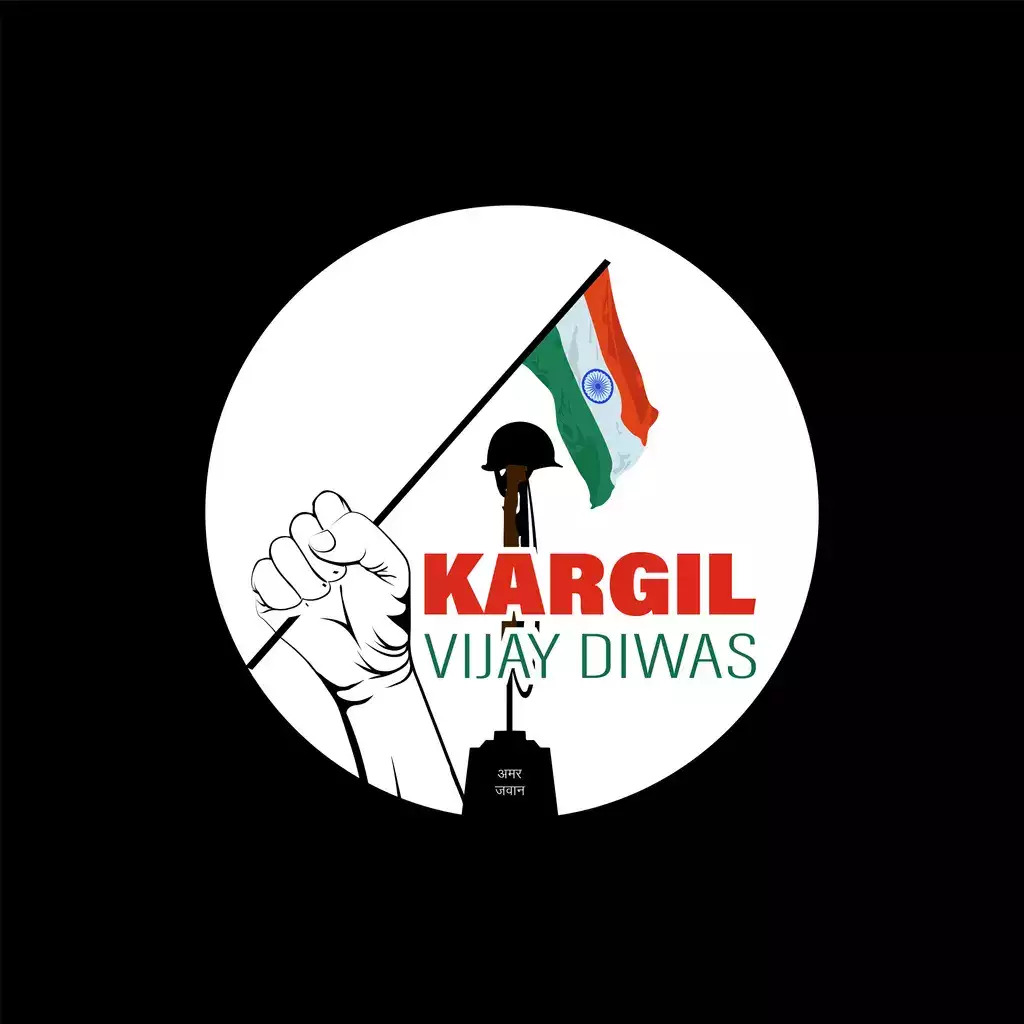
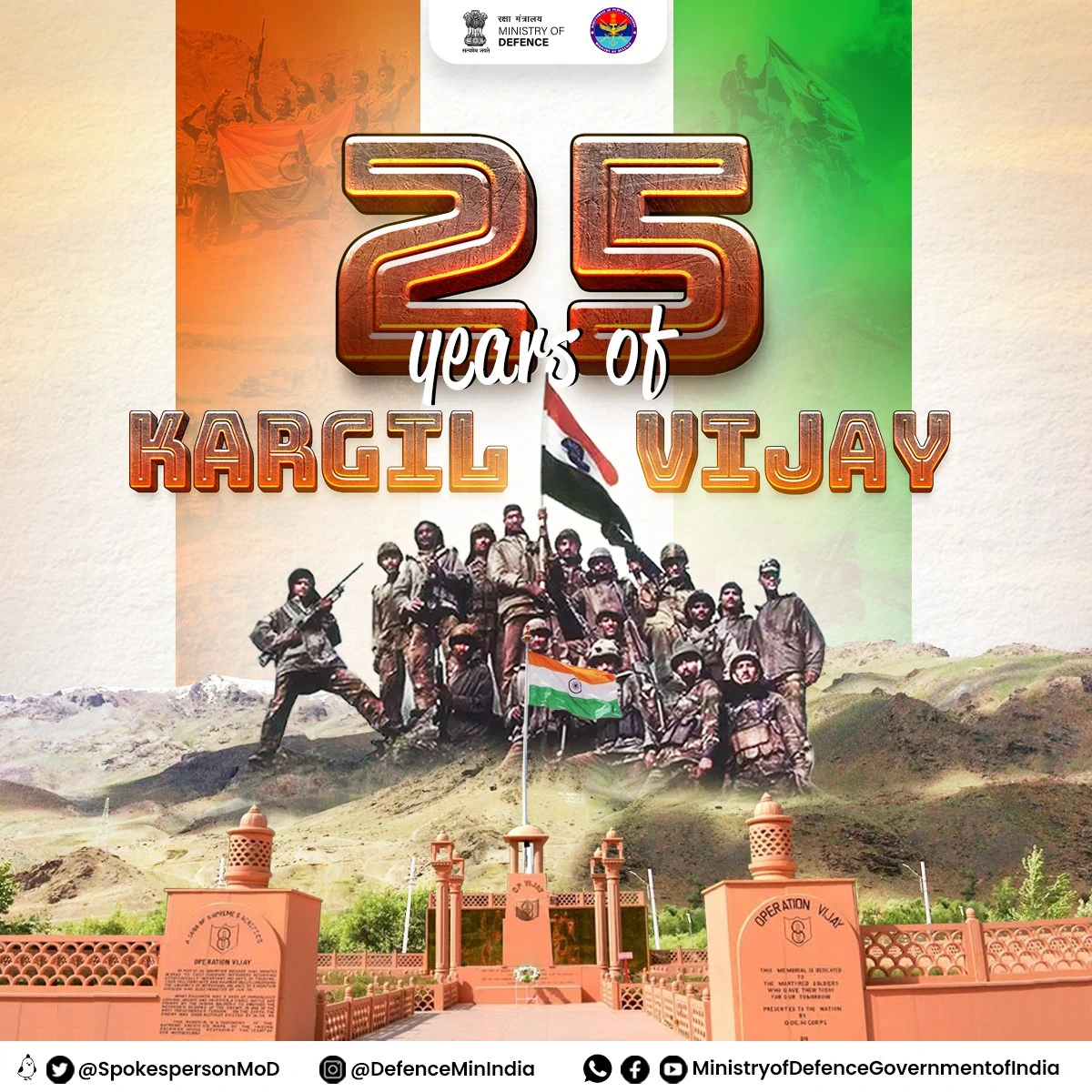
Introduction
The Kargil War, also known as Operation Vijay, was a fierce battle between India and Pakistan. It took place from May to July 1999 in the Kargil district of Jammu and Kashmir. This war was fought at very high altitudes in the difficult terrain of the Himalayas and is remembered as one of the most important and challenging conflicts in recent history. The war began when Pakistani troops and militants secretly entered Indian territory, aiming to cut off the link between Kashmir and Ladakh. In response, the Indian Armed Forces launched Operation Vijay, a full-scale military action involving over 200,000 soldiers, strategic planning, and coordination between the Army, Navy, and Air Force.
They carried out daring attacks, strategic bombings, and intense ground battles to reclaim the occupied land. As we mark the 25th anniversary of this great victory, it is important to look back at the details of the war, recognize the incredible sacrifices of the brave soldiers, and honour their unmatched bravery and dedication. This remembrance pays tribute to the heroes of Kargil and reminds us of the strong spirit and determination of the Indian Armed Forces in the face of great challenges.
Historical Background
The Kargil conflict’s roots lie in the long-standing Kashmir dispute between India and Pakistan. After the Indo-Pak war of 1971, both nations signed the Shimla Agreement in 1972. This agreement established the Line of Control (LoC), which divided the region of Jammu and Kashmir. Despite this agreement, tensions remained high between India and Pakistan, leading to frequent skirmishes along the LoC.
In early 1999, the situation escalated when Pakistani forces, disguised as Kashmiri militants, infiltrated the Indian side of the LoC in the Kargil sector. This move was part of a strategic plan to disrupt India’s control over the region. The infiltrators aimed to cut off the crucial Srinagar-Leh Highway, which was vital for the supply and communication lines to the Indian military in Ladakh and the Siachen Glacier. By doing this, they hoped to create significant logistical problems for India and force international intervention in the Kashmir dispute.
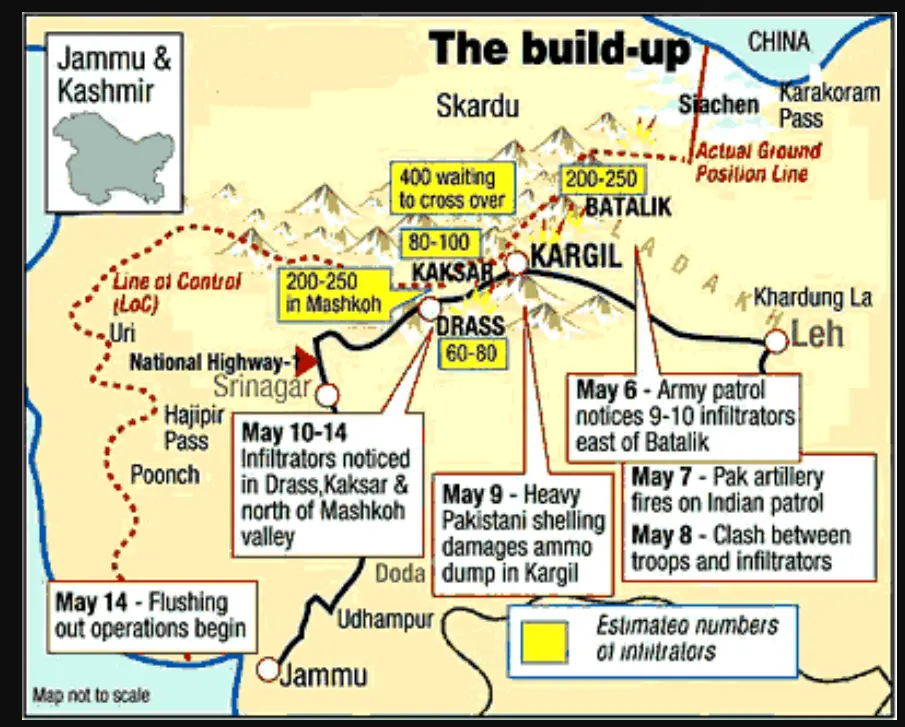
The infiltration was carefully planned to coincide with the melting of snow in the high-altitude areas, making it easier for the intruders to move across the difficult terrain. During the harsh winter months, these areas were less monitored, which allowed Pakistani forces to occupy strategic positions without being detected immediately. Once they had secured these positions, they fortified them with bunkers and heavy weaponry, making it challenging for Indian forces to reclaim the occupied areas.
The discovery of this infiltration led to the Kargil War, a fierce and difficult battle fought in one of the world’s most challenging terrains. The conflict required immense bravery and determination from the Indian Armed Forces, who faced not only the enemy but also the harsh conditions of high-altitude warfare. The Kargil War remains a significant chapter in the history of the Kashmir conflict, highlighting the ongoing struggle between India and Pakistan over this contested region.
Discovery of Infiltration
In May 1999, local shepherds in the Kargil region noticed unusual activities and reported them to the Indian Army. The army conducted reconnaissance missions and confirmed that heavily armed intruders had occupied key positions in the Kargil sector, including strategic peaks such as Tololing, Tiger Hill, and Point 4875. These high-altitude positions gave the intruders a significant advantage, allowing them to control Indian supply routes and communication lines.
At first, the Indian Army underestimated the scale of the infiltration, believing it was a minor incursion by militants. They thought it would be a small, localized issue that could be resolved quickly. However, as they gathered more intelligence, they realized the situation was much more serious. The infiltrators were well-equipped, well-positioned, and in large numbers. They had fortified their positions with bunkers and heavy weaponry, making it clear that this was a well-planned and coordinated military operation by Pakistani forces.
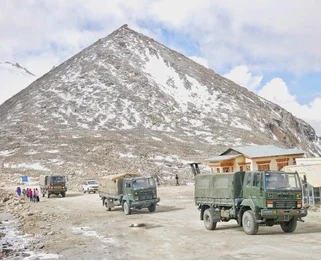
Recognizing the gravity of the situation, the Indian Army understood that reclaiming the occupied territory would require a full-scale military response. They could not allow the infiltrators to maintain control over these strategic positions, as it threatened the security and stability of the entire region. The Indian Armed Forces began planning Operation Vijay, a major military campaign to drive out the intruders and reclaim the lost territory.
The discovery of the infiltration marked the beginning of the Kargil War, a conflict that would test the courage, determination, and resilience of the Indian Armed Forces. The subsequent battles fought on these high-altitude peaks would become legendary, showcasing the bravery and sacrifice of the soldiers who fought to protect their nation. The Kargil War remains a testament to the challenges of defending mountainous borders and the unwavering spirit of the Indian military.
Indian Response
In response to the infiltration, the Indian government took swift and decisive action. They launched Operation Vijay, a major military campaign aimed at driving out the infiltrators and regaining control of the occupied territories. This operation was critical as it sought to reclaim strategic high-altitude positions captured by the enemy. The Indian Army mobilized a large number of troops, along with artillery and other resources, to address the challenge posed by the infiltrators.
Simultaneously, the Indian Air Force initiated Operation Safed Sagar to provide essential air support. This included aerial reconnaissance to map enemy positions, airstrikes to target key enemy strongholds, and logistical support to assist ground operations. The combination of ground and air efforts was crucial in the coordinated military response.
The terrain in Kargil presented extreme challenges. The region’s steep cliffs, narrow ridges, and high altitudes, ranging from 10,000 to 18,000 feet, made operations exceptionally difficult. Soldiers had to navigate through snow-covered peaks and endure harsh weather conditions, including freezing temperatures and high winds. These factors made every movement and operation risky and physically demanding.
To overcome these obstacles, the Indian Army employed high-risk strategies. They executed daring night-time assaults, which helped to catch the enemy off guard. Troops had to climb sheer cliffs under intense enemy fire, a task that required not only physical endurance but also mental toughness. Despite the extreme conditions and formidable enemy defences, the soldiers showed remarkable bravery and resilience.
The combined efforts of the Indian Army and Air Force were instrumental in pushing back the intruders and reclaiming the territory. The success of Operation Vijay was a testament to the determination and skill of the Indian military, who overcame significant challenges to achieve victory.
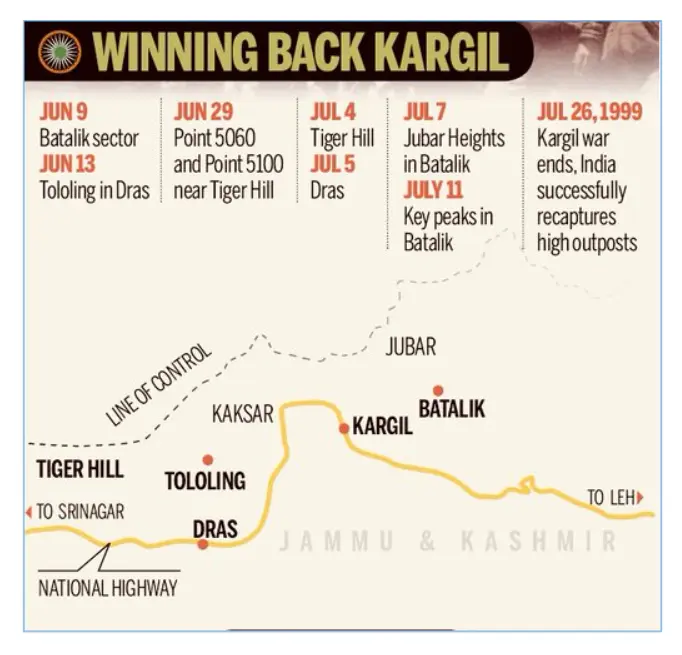
Leadership Involved on both sides
| Name | Position | Role and Contribution |
| K. R. Narayanan | President of India | Maintained constitutional integrity, boosted national morale, and used international diplomacy to secure global support. |
| Atal Bihari Vajpayee | Prime Minister of India | Navigated international diplomacy and domestic politics, contained the conflict within Kargil, and supported military operations. |
| General Ved Prakash Malik | Chief of the Army Staff | Led Operation Vijay, combining ground assaults and air strikes despite challenging terrain. |
| Lieutenant General Chandra Shekhar | Vice Chief of the Army Staff | Coordinated army operational logistics and strategy execution, ensuring effective troop mobilization and deployment. |
| Air Chief Marshal Anil Yashwant Tipnis | Chief of the Air Staff | Led the Indian Air Force in precision strikes at high altitudes, supporting ground operations. |
| Enemy Counterparts | ||
| Muhammad Rafiq Tarar | President of Pakistan | |
| Nawaz Sharif | Prime Minister of Pakistan | |
| General Pervez Musharraf | Chief of the Army Staff | |
Key Battles and Heroes
1. Battle of Tololing
The Battle of Tololing was one of the earliest and most critical engagements of the Kargil War. This battle took place on Tololing Hill, a strategically important peak that provided a commanding view over the Drass region. Indian forces, notably the 2 Rajputana Rifles, faced fierce resistance from well-entrenched Pakistani troops. The fight for Tololing was intense and gruelling, characterized by heavy artillery exchanges and close-quarters combat.
Major Rajesh Adhikari, who displayed exceptional bravery and leadership, played a crucial role in the recapture of this vital position. Despite being severely wounded, Major Adhikari’s determined efforts were instrumental in the success of the operation. His valour was recognized posthumously with the Maha Vir Chakra, India’s second-highest military honour. The capture of Tololing was a significant turning point, allowing Indian forces to gain a strategic advantage and better control the surrounding area. The successful recapture of this peak marked the beginning of a series of crucial victories for the Indian Army in the Kargil conflict.

2. Battle of Tiger Hill
The Battle of Tiger Hill was a defining moment in the Kargil War. The hill, a prominent and heavily fortified position, was crucial for controlling the surrounding area. The 18 Grenadiers, supported by other units, undertook a daring and challenging operation to reclaim the peak. The battle involved intense artillery bombardments followed by a series of difficult infantry assaults.
Captain Vikram Batra 13 Jak Rif, renowned for his courageous leadership and famous radio message “Yeh Dil Maange More,” played a central role in the recapture of Tiger Hill. His extraordinary bravery and tactical acumen were pivotal in overcoming the entrenched enemy forces. Captain Batra’s actions during this battle earned him the Param Vir Chakra, India’s highest military award. The successful recapture of Tiger Hill marked a crucial victory for the Indian Army, significantly impacting the overall progress of the conflict and boosting the morale of the troops.
3. Battle of Point 4875 (Batra Top)
Point 4875, also known as Batra Top, was a fierce and significant battle in the Kargil War. Named in honour of Captain Vikram Batra, this peak witnessed some of the most intense combat of the conflict. The battle was marked by severe weather conditions and difficult terrain, with Indian forces facing a well-entrenched enemy. Despite being heavily outnumbered, Captain Batra and his team exhibited extraordinary courage and tactical skill.
They engaged in hand-to-hand combat and overcame substantial obstacles to secure the peak. Captain Batra’s leadership and valour were crucial in this hard-fought victory, and his actions earned him the Param Vir Chakra posthumously. The battle for Point 4875 highlighted the determination and bravery of the Indian soldiers, who fought under extreme conditions and made significant sacrifices. The successful capture of this peak was a critical achievement in the broader context of Operation Vijay.
4. Battle of Drass
The Drass sector was another key area of the Kargil conflict, with its strategic importance due to its control over access to the Srinagar-Leh Highway. The 8 Sikh Regiment, led by Lieutenant Colonel Vishwanathan, was instrumental in recapturing crucial positions in this sector. The battle in Drass involved intense fighting as Indian forces sought to drive out the intruders from their fortified positions.
The challenging terrain and weather conditions made the battle even more difficult. Lieutenant Colonel Vishwanathan’s leadership and the determination of his troops were crucial in overcoming the enemy forces. The successful recapture of Drass allowed Indian forces to secure a vital route for maintaining supply lines to the Siachen Glacier and other forward areas. The battle demonstrated the resilience and tenacity of the Indian soldiers, who played a pivotal role in the overall success of Operation Vijay.
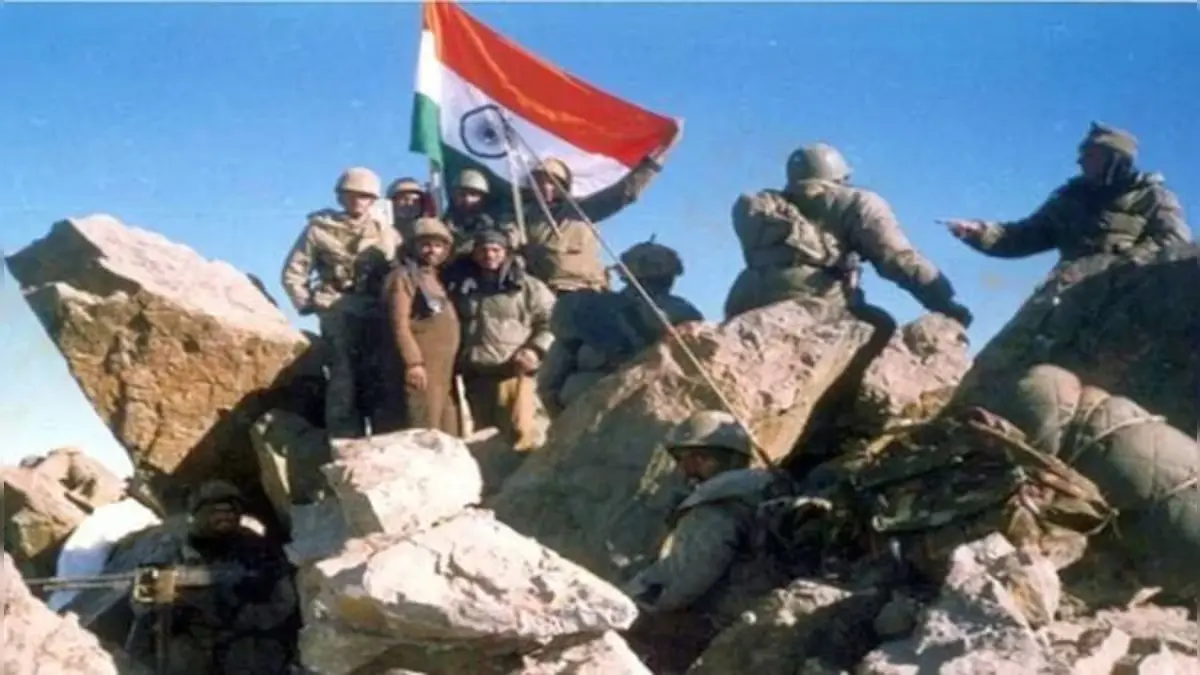
5. Battle of Batalik
The Battle of Batalik was a significant engagement in the Kargil War, focusing on the Batalik sector. The area was vital due to its strategic location and the heights occupied by the enemy. The 1/11 Gorkha Rifles, along with other units, fought valiantly to reclaim these crucial positions. Lieutenant Manoj Kumar Pandey, who was awarded the Param Vir Chakra posthumously, played a key role in the battle.
His leadership and bravery were pivotal in the successful recapture of Jubar Top, a critical height in the sector. Despite facing fierce resistance and difficult conditions, Lieutenant Pandey and his men managed to secure the position through relentless effort and courage. The battle for Batalik was marked by intense fighting and significant casualties, reflecting the determination and sacrifice of the Indian soldiers. The recapture of this sector was a crucial victory in the broader context of the Kargil conflict, contributing to the overall success of Operation Vijay.
Role of the Indian Navy
The Kargil conflict, which unfolded primarily as a land-based battle in the rugged terrains of Kargil, saw significant contributions from the Indian Navy, which played a crucial supporting role. While the ground forces engaged in intense fighting on the high-altitude peaks, the Navy’s involvement was vital in ensuring that the conflict did not escalate into maritime tensions. To achieve this, the Indian Navy launched Operation Talwar, a strategic operation designed to safeguard India’s maritime interests and deter any potential interference from Pakistani naval forces.
Operation Talwar was carefully planned and executed. The Indian Navy deployed its Western Fleet to the North Arabian Sea, an area of significant strategic importance. The Western Fleet was a powerful naval force, and its deployment was a deliberate move to exert pressure on Pakistan. The Navy carried out a series of naval exercises and maintained constant patrolling of the area. This continuous naval presence was crucial for several reasons. It showcased India’s readiness to respond to any maritime threats and acted as a deterrent against Pakistani naval actions that could complicate the conflict.
One of the primary objectives of Operation Talwar was to enforce a maritime blockade. By controlling the sea routes and restricting Pakistani naval movements, the Indian Navy ensured that Pakistan could not use its naval resources to support its ground operations or disrupt Indian supply lines. The blockade played a critical role in maintaining the stability of the region and protecting India’s maritime interests during the conflict.
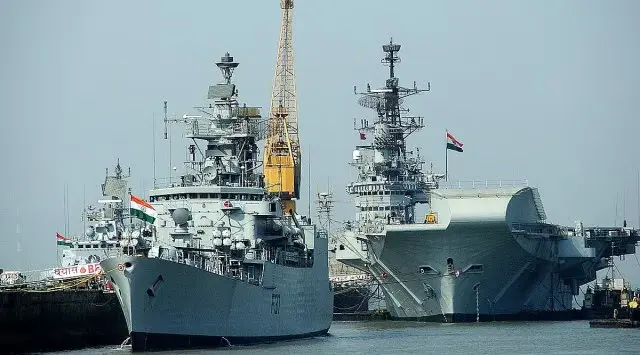
The presence of the Western Fleet also served as a significant deterrent. The Indian Navy’s show of strength made it clear to Pakistan that any attempt to engage in naval warfare would be met with a strong and immediate response. This helped to ensure that the conflict remained focused on the land battles in Kargil and did not spread to the seas. By maintaining a robust naval posture, the Indian Navy effectively prevented the escalation of the conflict into a broader regional issue.
Additionally, Operation Talwar highlighted the Indian Navy’s ability to operate under high-pressure situations and its strategic importance in national defense. The Navy’s actions not only supported the Indian Army’s efforts on the ground but also contributed to the overall military strategy of India during the Kargil War. The successful implementation of Operation Talwar underscored the critical role of naval power in modern conflicts, even when the primary battles occur on land.
Role of the Indian Air Force
The Indian Air Force (IAF) played a vital and multifaceted role during the Kargil War, significantly contributing to the overall success of the conflict through its operations. Central to their efforts was Operation Safed Sagar, which was launched to provide crucial aerial support to the Indian Army’s ground troops engaged in the high-altitude battles of Kargil.
Operation Safed Sagar involved a range of tasks including airstrikes on enemy positions and supply routes. The IAF deployed various aircraft types for these missions. The MiG-21s, MiG-27s, and Mirage 2000s were extensively used to target the entrenched Pakistani positions, disrupt their supply lines, and provide close air support to Indian ground forces. These aircraft were instrumental in striking at key enemy locations, which helped to weaken the enemy’s defensive capabilities and provide a tactical advantage to the Indian troops on the ground.
Operating in the Kargil sector presented significant challenges for the IAF. The high-altitude terrain, with peaks rising up to 18,000 feet, posed difficulties for pilots who had to navigate thin air and harsh weather conditions. Additionally, the risk of encountering enemy surface-to-air missiles made the missions more perilous. Despite these obstacles, the IAF managed to maintain a high operational tempo, executing numerous sorties with precision and effectiveness.
A notable and tragic incident during Operation Safed Sagar was the shooting down of an IAF MiG-21 by a Pakistani missile. Squadron Leader Ajay Ahuja, the pilot of the downed aircraft, was captured by Pakistani forces and tragically killed. His sacrifice was deeply mourned, and he was posthumously awarded the Vir Chakra, a recognition of his bravery and dedication. This incident highlighted the risks faced by the IAF personnel and their unwavering commitment to their duties.

Medical and Logistical Challenges
The Kargil War posed severe medical and logistical challenges due to the high-altitude conditions and rugged terrain. Soldiers fighting in the Kargil sector had to endure extreme weather, low oxygen levels, and the risk of altitude sickness. The high altitude, with peaks reaching up to 18,000 feet, significantly affected the health and performance of the troops. Many soldiers suffered from acute mountain sickness, which included symptoms like headaches, nausea, and dizziness. The Indian Army’s medical corps played a critical role in addressing these health issues. They provided emergency care under extremely challenging conditions and worked to ensure the survival and recovery of injured soldiers.
Medical evacuations were particularly complex due to the harsh environment. Injured soldiers required prompt evacuation to lower altitudes where they could receive proper treatment. The process often involved airlifting casualties using helicopters, which was a risky operation given the altitude and the enemy’s presence. Despite these difficulties, the medical teams were instrumental in managing the health crises and saving lives.
On the logistical front, maintaining supply lines in such rugged terrain was a major challenge. The Indian Army had to ensure that troops stationed at high altitudes received adequate supplies of food, ammunition, and equipment. Helicopters were extensively used to transport these essentials to forward positions, overcoming the limitations of the treacherous landscape. In addition, the army’s engineers worked tirelessly to build makeshift roads and bridges. These temporary structures were crucial for facilitating the movement of troops and supplies. The logistical efforts were vital for sustaining the operations and ensuring that the army could continue its push against the enemy despite the harsh conditions.
Overall, the medical and logistical support during the Kargil War was essential for the success of the operations. The challenges faced were significant, but the effective management of these aspects played a crucial role in the Indian Army’s ability to conduct sustained and successful military operations in such difficult terrain.

International Reaction and Diplomatic Efforts
The Kargil conflict, despite being a regional issue, attracted considerable international attention and involvement. As the conflict unfolded, the global community closely monitored the situation, and many countries expressed their views and support. India’s stance was broadly supported internationally, with numerous nations condemning Pakistan’s intrusion into Indian territory and calling for the immediate withdrawal of Pakistani forces from the Kargil region.
One of the most significant contributors to the diplomatic efforts was the United States. President Bill Clinton played a pivotal role in addressing the crisis. He engaged in direct dialogue with Pakistani Prime Minister Nawaz Sharif, urging him to pull back Pakistani troops from the Kargil heights. The U.S. pressure was part of a broader diplomatic strategy to resolve the conflict and reduce the risk of further escalation.
International media coverage was extensive and played a crucial role in shaping global perceptions of the conflict. Reports highlighted the aggressive and unprovoked nature of the Pakistani incursion into Indian territory. This coverage was instrumental in garnering international sympathy and support for India. The portrayal of the conflict in global media outlets emphasized the violation of the Line of Control (LoC) and the challenges faced by Indian forces, further swaying public and governmental opinion in favour of India.
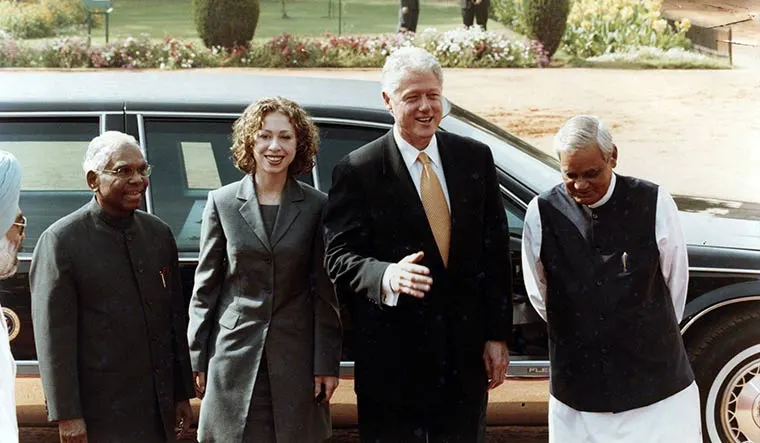
The international community’s reaction also included diplomatic condemnation of Pakistan’s actions. Major powers and international organizations voiced their disapproval, which helped to isolate Pakistan diplomatically. The collective condemnation and diplomatic pressure from various countries were significant in pressuring Pakistan to seek a resolution and eventually withdraw its forces from the conflict zone.
Overall, the international reaction and diplomatic efforts were crucial in shaping the outcome of the Kargil War. The support for India and the pressure exerted on Pakistan played a key role in addressing the conflict and facilitating a resolution. The global response not only highlighted the severity of the situation but also demonstrated the impact of international diplomacy in resolving regional conflicts.
Conclusion of the War
By July 1999, after intense fighting and significant losses on both sides, Indian forces achieved a decisive victory in the Kargil War. The conflict, which had been ongoing since May 1999, saw Indian troops fighting fiercely to reclaim the high-altitude positions occupied by infiltrating Pakistani forces. After months of arduous combat, strategic operations, and overcoming formidable challenges, the Indian Army successfully recaptured the majority of the territory held by the infiltrators. This military success was a significant achievement for India and marked the culmination of the conflict.
On July 26, 1999, the Indian government officially declared the mission a success, bringing the Kargil War to a close. This date has since been commemorated annually as Kargil Vijay Diwas, a day dedicated to honouring the bravery, sacrifice, and dedication of the Indian soldiers who fought in the conflict. The celebrations on this day serve as a reminder of the courage of those who served and the high price paid for the nation’s security.
The victory in Kargil, while significant, came at a heavy cost. The war resulted in the loss of over 500 Indian soldiers, with many more wounded. The conflict also inflicted considerable casualties on the Pakistani side, though exact figures remain less clear. The Indian Army’s efforts were marked by incredible bravery and resilience, as soldiers battled not only the enemy but also the harsh and challenging conditions of the high-altitude terrain.

The successful recapture of key positions, such as Tiger Hill and Tololing, was instrumental in forcing the withdrawal of Pakistani forces from the conflict zone. These strategic victories underscored the effectiveness of India’s military strategy and the determination of its forces. The end of the war reaffirmed India’s territorial integrity and sovereignty over the disputed region of Kargil, reinforcing the country’s resolve to defend its borders.
The Kargil War left a lasting impact on India, highlighting the valour of its armed forces and the effectiveness of its military strategies. It also demonstrated the importance of international support and diplomatic efforts in resolving conflicts. The legacy of the Kargil War continues to inspire national pride and remembrance, reflecting the enduring spirit and sacrifice of the soldiers who played a crucial role in this significant chapter of Indian history.
In conclusion, the Kargil War was a testament to the courage and determination of the Indian military. The conflict, marked by significant sacrifices and strategic victories, reaffirmed India’s commitment to safeguarding its territorial integrity and provided a powerful reminder of the price of peace and security. The memory of Kargil Vijay Diwas serves as an enduring tribute to the bravery and sacrifices of those who served in one of India’s most challenging military engagements.
Tribute to the Heroes
Captain Vikram Batra of the 13 Jammu and Kashmir Rifles is remembered for his extraordinary valor during the Kargil War. His heroic leadership was pivotal in the capture of Point 4875 and Peak 5140, where he displayed unmatched bravery. Captain Batra’s famous battle cry, “Yeh Dil Maange More,” became a symbol of the Indian Army’s determination. His selfless sacrifice and exceptional courage earned him the Param Vir Chakra posthumously, honoring his significant contributions to India’s victory. His legacy continues to inspire soldiers and civilians alike.
Lieutenant Manoj Kumar Pandey of the 1/11 Gorkha Rifles is celebrated for his fearless actions during the Kargil War. He played a crucial role in the capture of Jubar Top, a strategic position heavily contested by enemy forces. His leadership and valor under intense fire were instrumental in securing this important objective. Lieutenant Pandey’s dedication and bravery earned him the Param Vir Chakra posthumously, reflecting his commitment to his country and the high standards of military excellence. His actions remain a source of pride and inspiration for the Indian Armed Forces.
Grenadier Yogendra Singh Yadav of the 18 Grenadiers is renowned for his remarkable bravery at the age of 19. During the intense Battle of Tiger Hill, Yadav displayed extraordinary courage despite severe injuries. His relentless determination and exceptional valor in capturing Tiger Hill, one of the most challenging positions, earned him the Param Vir Chakra. His bravery at such a young age and under extremely adverse conditions highlights the spirit and sacrifice of the Indian soldiers, making him a revered figure in Indian military history.
Major Rajesh Adhikari of the 18 Grenadiers is remembered for his critical role in recapturing Tololing Hill. His leadership and bravery were vital in overcoming the entrenched enemy positions on this strategic height. Major Adhikari’s exceptional dedication and courage during the battle were recognized with the Maha Vir Chakra posthumously. His actions were instrumental in the success of Indian forces in the Kargil War, and his sacrifice is honoured as a significant contribution to India’s military achievements.
Captain Anuj Nayyar of the 17 Jat Regiment played a key role in capturing the Pimple Complex during the Kargil War. His leadership and valour in this crucial operation were pivotal in reclaiming important ground. Despite facing intense enemy fire, Captain Nayyar’s courage and tactical acumen led to the successful capture of the complex. His actions were posthumously honoured with the Maha Vir Chakra, underscoring his bravery and commitment to his country during the conflict.
Rifleman Sanjay Kumar of the 13 Jammu and Kashmir Rifles exhibited extraordinary bravery during the Battle of Flat Top. Despite being severely injured, he charged an enemy bunker, neutralizing the threat and contributing significantly to the success of the operation. His courageous actions earned him the Param Vir Chakra, recognizing his unwavering dedication and heroism. Rifleman Kumar’s bravery in the face of adversity remains a powerful testament to the valor of the Indian Armed Forces.
Major Vivek Gupta of the 2 Rajputana Rifles led a successful attack on Point 4590, showcasing exceptional bravery and leadership. His strategic planning and courageous execution played a critical role in overcoming enemy defenses and securing this vital position. Major Gupta’s sacrifice and valor were recognized with the Maha Vir Chakra posthumously, highlighting his significant contributions to the success of the Kargil War and his dedication to his country.
Captain Haneef Uddin of the 11 Rajputana Rifles was a crucial figure in the recapture of Point 4875. His exceptional courage and leadership under fire were instrumental in the success of this operation. Despite the intense conditions, Captain Uddin’s determination and bravery led to the successful recapture of the strategically important position. His valour was recognized with the Maha Vir Chakra posthumously, honouring his critical role in the victory and his unwavering commitment to his duties.
Major Padmapani Acharya of the 2 Rajputana Rifles demonstrated extraordinary valour during the capture of Point 5140. Despite severe injuries, his leadership and courage were crucial in securing this strategic location. Major Acharya’s actions, under extreme conditions, earned him the Maha Vir Chakra posthumously, reflecting his dedication and bravery. His sacrifice is remembered as a significant contribution to India’s success in the Kargil War.
Captain Neikezhakuo Kenguruse of the Rajputana Rifles is honoured for his bravery during the Kargil War. Known for his heroism and sacrifice, Captain Kenguruse displayed exceptional courage in the face of intense enemy resistance. His actions during the conflict earned him the Maha Vir Chakra posthumously, recognizing his dedication and the ultimate sacrifice he made for his country. His legacy is celebrated as a testament to the valour and commitment of the Indian Armed Forces.
Flt Lt K Nachiketa of the Indian Air Force played a vital role during the Kargil War by providing essential air support. His contributions included conducting crucial airstrikes and reconnaissance missions that significantly impacted ground operations. Flt Lt KNachiketa’s actions were instrumental in maintaining air superiority and supporting the troops on the ground. His bravery and commitment earned him the Vir Chakra, honouring his pivotal role in the conflict and his dedication to safeguarding the nation.
Flight Lieutenant Gunjan Saxena of the Indian Air Force is celebrated for her courage and resilience during the Kargil War. As a MiG-21 pilot, she flew numerous combat missions, providing critical support to the ground troops. Despite the intense conditions, Flight Lieutenant Saxena’s bravery and effective flying skills were crucial to the success of the operations. Her contributions were recognized with the Sena Medal, reflecting her exceptional courage and commitment during the conflict.
Impact and Legacy of the Kargil War
The Kargil War, fought between May and July 1999, left an indelible mark on India, shaping its defence strategies and policies in profound ways. Here’s a look at the lasting impact and legacy of this significant conflict:
1. Enhanced Military Readiness
The Kargil War underscored the necessity for better intelligence and modernized military equipment. The unexpected nature of the conflict revealed gaps in India’s surveillance and communication capabilities. In response, the Indian Armed Forces undertook significant upgrades, incorporating advanced technology and modernizing equipment to better address high-altitude warfare.
2. Reformed Defence Policies
The lessons from Kargil led to substantial changes in India’s defence policies. The conflict highlighted the need for a comprehensive review of military strategies and the restructuring of defence priorities. This resulted in increased focus on high-altitude warfare training and the integration of advanced tactics into the military curriculum.
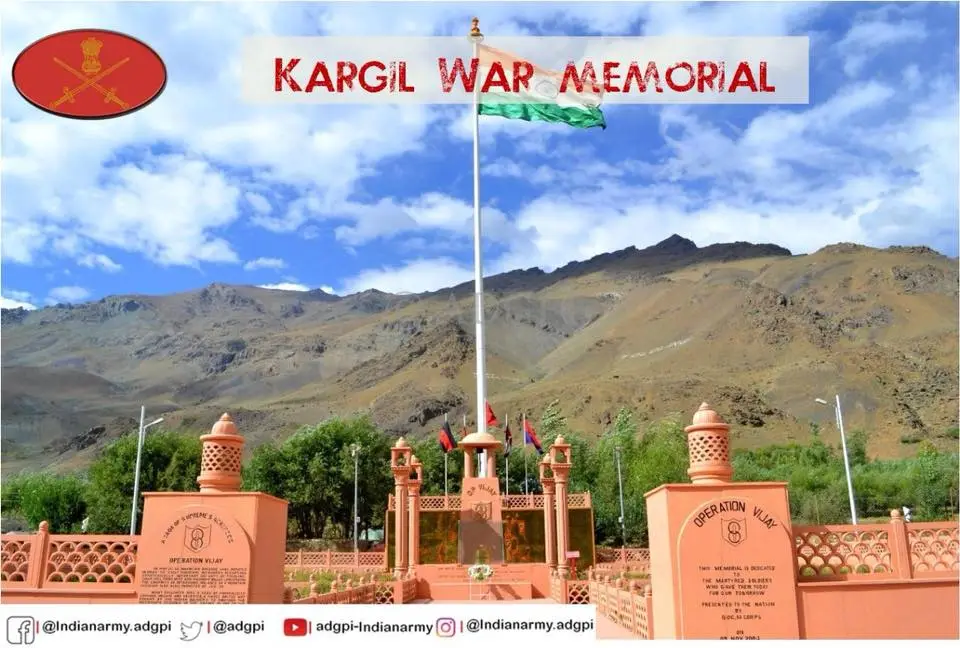
3. War Memorials and Tributes
The sacrifices made by soldiers during the Kargil War are commemorated through war memorials in Drass, Kargil, and other key locations. These sites serve as solemn reminders of the bravery and dedication of the soldiers who fought in harsh conditions. The memorials ensure that their sacrifices are honored and remembered by future generations.
4. Cultural Impact
The Kargil War has been immortalized in Indian culture through books, films, and documentaries. Movies such as “LOC Kargil” and “Lakshya,” along with various documentaries, have portrayed the heroism and struggles of the Indian Armed Forces. These representations have played a crucial role in keeping the spirit of the Kargil War alive in the public consciousness and inspiring new generations.
5. Lessons Learned
One of the critical outcomes of the Kargil War was the recognition of the need for specialized training and equipment for high-altitude warfare. The Indian Army incorporated the lessons learned from the conflict into its training modules, enhancing its preparedness for similar challenges in the future. This focus on specialized training ensures that the forces are better equipped to handle the unique demands of high-altitude combat.
In summary, the Kargil War’s impact extends beyond the battlefield, influencing India’s defence strategies, policies, and cultural narratives. The legacy of the conflict continues to inspire and inform the nation’s approach to military readiness and remembrance.
Remembrance and Commemoration
Every year on July 26, India commemorates Kargil Vijay Diwas to honour the valiant soldiers who fought in the Kargil War. This significant day is marked by a series of solemn and patriotic events that pay tribute to the sacrifices made by these brave individuals.

The primary ceremony takes place at the Kargil War Memorial in Drass, where the President and Prime Minister of India, along with senior military leaders, gather to lay wreaths and pay their respects. This memorial stands as a poignant reminder of the courage and dedication displayed by the soldiers during the conflict.
In addition to the official ceremonies, various events are organized across the country. Educational institutions, government bodies, and organizations conduct activities to raise awareness about the Kargil War among the younger generation. These events include lectures, discussions, and exhibitions that highlight the significance of the war and the heroic efforts of the soldiers.
Parades featuring military personnel and cultural programs showcasing patriotic songs and performances further enhance the day’s significance. These celebrations foster a deep sense of patriotism and national pride, connecting the youth with the sacrifices made by their forebears.
The remembrance of Kargil Vijay Diwas ensures that the legacy of the Kargil heroes is preserved and honoured. By educating new generations about the valour and sacrifices of the soldiers, India ensures that the spirit of bravery and dedication continues to inspire and guide future generations.
Conclusion
As we mark the 25th anniversary of Kargil’s victory, it is crucial to reflect on and honour the immense sacrifices made by the brave soldiers who defended our nation. Their exceptional courage, unwavering dedication, and relentless spirit are enduring symbols of heroism that inspire us all. The triumph at Kargil was not merely a military success but a profound testament to the resilience and patriotism of the Indian Armed Forces.
Also Read Transforming ECHS: 5 Major Changes For Better Facilities
The Kargil War stands as a powerful reminder of the bravery exhibited by our soldiers, who faced tremendous challenges and adversities with unflinching resolve. By delving into the history, key battles, and the remarkable individuals who played pivotal roles in this conflict, we gain a deeper appreciation for their sacrifices and the significance of their victory.
This comprehensive account serves to honour and celebrate the valour of those who fought to protect our borders. Their legacy is etched into the fabric of our national consciousness, ensuring that their heroism will never be forgotten. Let us remember and pay tribute to these heroes, ensuring that their legacy of bravery and dedication continues to inspire and resonate through generations.
Want to get Daily Updates on post-retirement Affairs Click here to join Our WhatsApp Group





